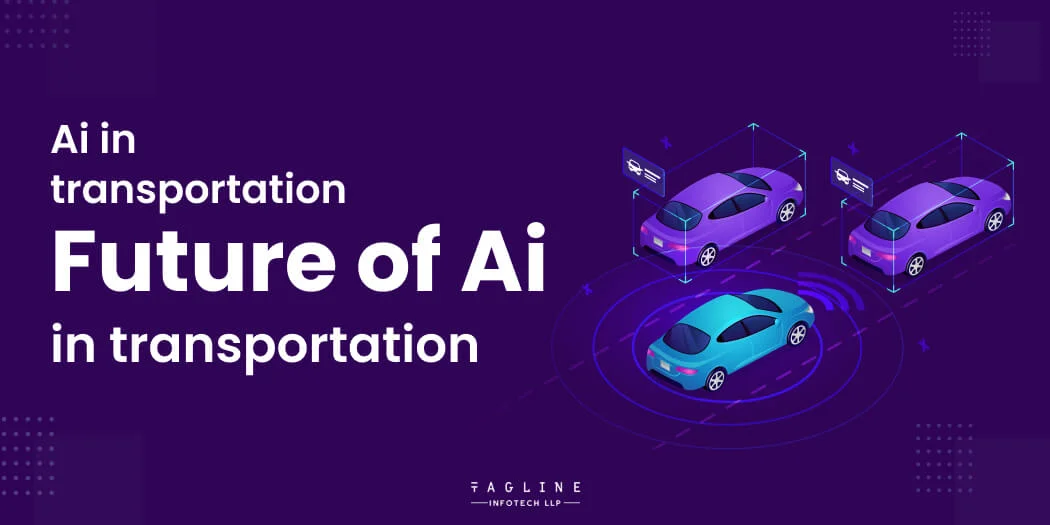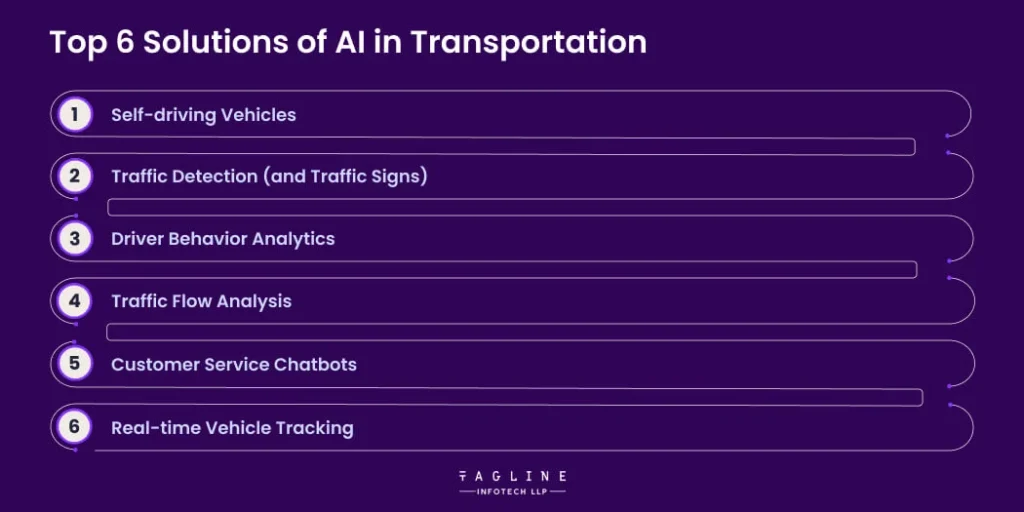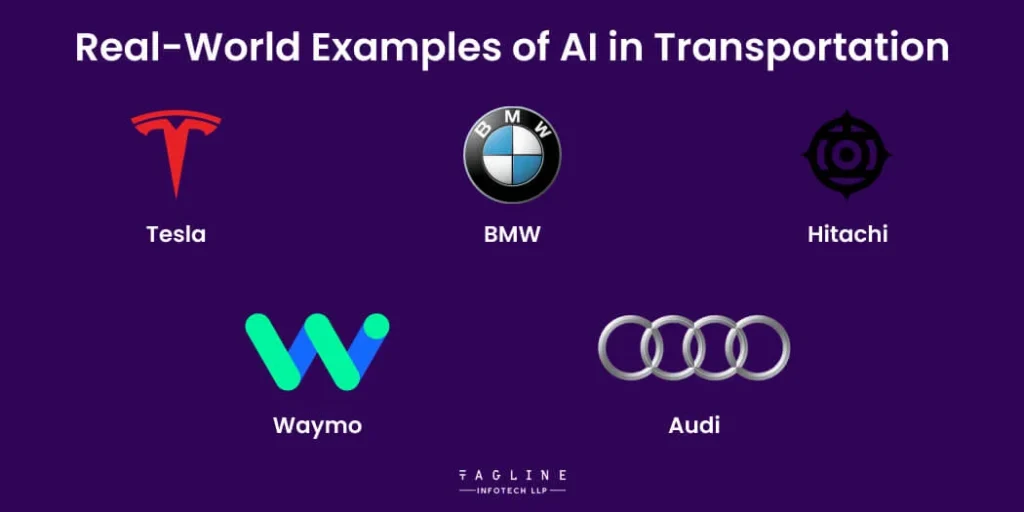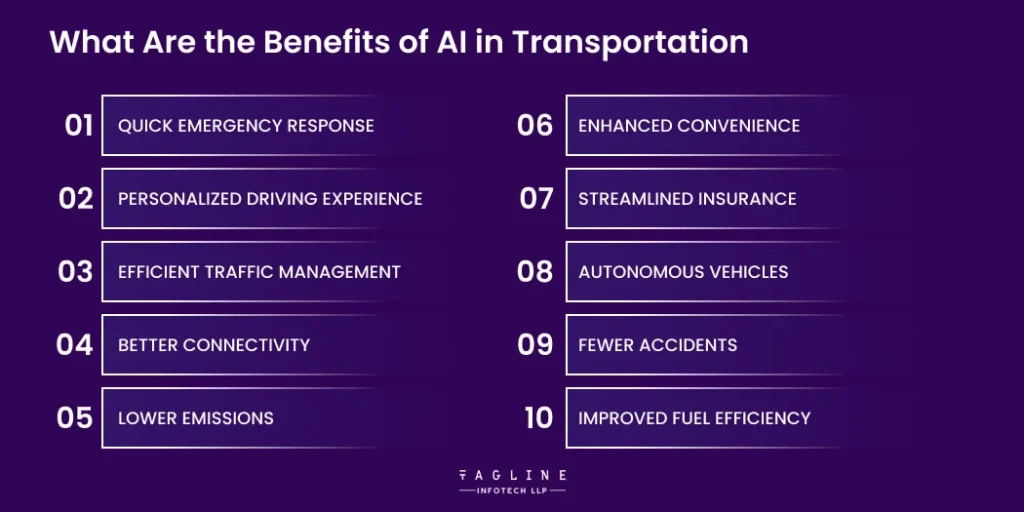Role of Python Libraries in Image Processing
October 30, 2025
Home >> AI >> Ai in transportation: Future of Ai in transportation

The transportation industry has seen tremendous innovation, starting with the steamboat in 1787, followed by bicycles, motor cars, trains, and aircraft. Artificial Intelligence (AI) is driving a new era of advancements. AI enhances transportation with self-driving cars, road condition monitoring, and traffic flow analysis, improving reliability, safety, and efficiency.
The global market for AI in transportation is expected to reach $3.87 billion by 2026, fueled by computer vision and machine learning investments. These technologies aim to reduce accidents, ease congestion, and enhance passenger safety. In smart cities, AI monitors things like parking violations and traffic flow, helping the city run smoothly. The technology behind AI, such as computer vision and machine learning, is continuously advancing, promising even more improvements in the future. Overall, AI is making transportation smarter, safer, and more efficient. The automotive AI market is forecast to grow at a CAGR of 25.5% from 2023 to 2030, signaling the rise of autonomous vehicles and ongoing innovation.

The concept of self-driving vehicles isn’t new; it dates back to 1939 with General Motors. However, it’s the current advancements in AI that have made it possible to develop intelligent systems that allow cars to drive themselves. These systems use computer vision techniques like object detection to understand and respond to their environment. Creating AI for self-driving cars involves training algorithms with large amounts of data. This training helps the AI recognize objects such as other vehicles, road signs, traffic lights, lane markings, and pedestrians. The AI can then make decisions like braking, turning, speeding up, or slowing down.
Autonomous vehicles use cameras and sensors to gather data. For the AI to be effective, it needs a constant flow of data. However, challenges such as collecting sufficient data, handling bad weather, navigating uneven terrain, and dealing with poor lighting conditions or unidentified objects remain.
Leading companies like Tesla, Uber, Waymo, and Motional are pioneers in this field. Tesla, for example, uses a vision-based approach that relies on video and image data collected by cameras, instead of HD maps and LIDAR. This approach requires precise accuracy because the neural networks are trained solely on visual data. Tesla collects about 1.5 petabytes of data, including millions of annotated videos and objects. This process combines human review with automated annotation tools to ensure high accuracy.
AI technology isn’t limited to self-driving cars; it’s also used in trucks, buses, and airport shuttles, significantly impacting logistics and supply chains. McKinsey predicts that self-driving trucks could cut operating costs by around 45% and reduce environmental impact.
In India, road accidents are a significant concern, with over 150,000 fatalities reported each year. Running red lights contributes to many of these accidents, causing numerous injuries and deaths. The issue isn’t the traffic lights but human error. Drivers make mistakes, leading to accidents. Autonomous vehicles, combined with smart city technology, can help reduce these risks. Carmakers are focusing on making self-driving cars that can recognize traffic signals. These cars use AI and computer vision to detect traffic lights in different conditions, such as poor lighting, bad weather, and obstructions.
Here’s how it works: the car’s cameras spot a traffic light, analyze the image, and if it’s red, the car stops. The challenge is to ensure the system doesn’t mistake other lights, like streetlamps or billboards, for traffic lights. Accurate detection is crucial to avoid accidents. To improve traffic light detection, data must be carefully labeled. Two methods are common:
1. Labeling the light and its casing separately.
2. Defining each traffic light class by the color of the lights.
In smart cities, additional data helps self-driving cars understand traffic light positions better. Researchers are using convolutional neural networks (CNNs) and algorithms that combine image classification and object detection to recognize traffic lights accurately. They’ve also used YOLOv3 for real-time detection. Though progress has been made, these systems aren’t yet 100% accurate, and they need to be to ensure safety.
AI is transforming transportation safety by monitoring and analyzing driver behavior through telematics devices. These devices, equipped with advanced AI algorithms, keep track of various driving aspects, including:
This collected data is crucial for multiple reasons. Fleet managers can maintain vehicles more effectively and ensure drivers follow safe practices. Insurance companies can use this data to develop accurate pricing models, offering lower premiums to safer drivers. By leveraging AI to understand and improve driver behavior, we can make roads safer, decrease the chances of accidents, and ensure fair insurance pricing based on individual driving habits.
Commuters often face the issue of traffic congestion, but AI technology offers a solution. AI algorithms analyze real-time data from sensors, traffic cameras, and GPS devices to optimize traffic flow. These smart traffic management systems can adjust signal timings and reroute vehicles dynamically, helping to ease congestion and improve traffic efficiency.
Moreover, AI keeps passengers informed with crucial updates. Commuters receive alerts about accidents, traffic forecasts, and road blockages. AI also provides the best routes to avoid traffic, ensuring quicker and smoother journeys. By reducing congestion and wait times, AI enhances road safety and improves the overall commuting experience.
AI chatbots are revolutionizing how businesses communicate with customers. Using Natural Language Processing (NLP), these chatbots can understand and answer questions about car features, provide useful information, and help solve problems. They handle routine tasks such as assisting with car model selection, scheduling test drives, and collecting customer feedback, freeing human agents to tackle more complex issues.
By adopting AI-driven chatbots, companies can boost customer service efficiency, shorten response times, and offer a more personalized and engaging user experience.
AI-powered vehicle tracking systems offer real-time updates on the location, status, and condition of a fleet. By using GPS data, sensors, and predictive analytics, businesses can improve route planning, monitor fuel consumption, and schedule maintenance in advance. This leads to better fleet management, lower fuel costs, improved delivery times, and enhanced overall efficiency of transportation operations.
Additionally, because the data is stored in the cloud, it can be accessed from any device at any time, providing flexibility and convenience.

AI is revolutionizing the automotive industry, making it more advanced, automated, and efficient. Both large enterprises and emerging startups are increasingly incorporating AI into their transportation solutions. Here are some notable examples:
Tesla
Tesla utilizes AI to enable self-driving features in its vehicles. Their AI systems also monitor driver behavior, such as fatigue and sleepiness, to help prevent accidents.
BMW
BMW employs over 400 AI applications across its operations. Their latest models come with AI-powered personal assistants that enhance driver convenience and safety by performing tasks based on driver preferences and behaviors.
Hitachi
Hitachi is a leader in AI-driven transportation solutions, particularly known for its predictive fleet maintenance software. By leveraging IoT and AI, Hitachi analyzes extensive data to offer detailed fleet monitoring, ensuring the longevity and efficiency of fleet assets.
Waymo
Waymo, formerly the Google self-driving car project, specializes in autonomous driving technology. They use AI to enable self-driving capabilities in their fleet of delivery vans, taxis, and tractor-trailers.
Audi
Audi employs AI and computer vision to inspect vehicle sheet metal during production. These technologies detect even the smallest cracks, allowing Audi to eliminate faulty parts before the cars reach the market.

AI is changing the game in transportation, making it smarter and more efficient. When combined with other technologies like IoT, machine learning, cloud computing, big data, and 5G, AI enhances connectivity between vehicles, leading to better, safer, and more advanced transportation systems. AI is turning the vision of self-driving cars into a reality. This revolution promises a new way to travel, focusing on safety, convenience, and sustainability. AI helps cut down traffic jams, improve passenger safety, reduce accidents, lower carbon emissions, and save costs.
Key Benefits of AI in Transportation
AI can instantly alert emergency services during accidents, speeding up response times.
AI customizes in-car entertainment and settings based on your preferences, making each ride more enjoyable.
AI helps ease traffic congestion, making driving smoother and less stressful.
AI enhances the connection between vehicles and surrounding infrastructure, improving overall travel efficiency.
Smart driving technologies reduce emissions, contributing to cleaner air and fighting climate change.
AI handles route planning and navigation, allowing drivers to focus on other things.
AI helps insurance companies better assess risks, set accurate premiums, and detect fraud.
AI is crucial in developing self-driving cars, making roads safer, and bringing us closer to a future with driverless vehicles.
AI provides real-time traffic updates and hazard warnings, reducing the chances of accidents.
AI helps drivers make smarter decisions about acceleration and braking, leading to better fuel economy.
Looking ahead as AI technology advances, we’ll see even more innovative applications in transportation. Companies are investing in AI to stay competitive and lead the industry forward.
AI has already significantly impacted transportation, but we’re just beginning to explore its full potential. In the future, AI will delve deeper into the industry, taking on more complex roles beyond automation and error reduction. Similarly, the future of AI in education holds immense promise, with advancements expected to revolutionize how students learn and educators teach.
Anticipated advancements include predictive capabilities that will transform decision-making and redefine how we transport goods and passengers. The move towards fully autonomous vehicles is a key milestone, with current AI-driven vehicles operating at levels 1 to 3. Over the next decade, we could see cars achieving full autonomy, allowing drivers to relax entirely.
AI will also enhance traffic management, reducing congestion and improving urban mobility. With ongoing innovations in autonomous technology and predictive analytics, AI is set to revolutionize the transportation sector, making it more efficient and effective.
Artificial intelligence is revolutionizing the transportation sector through the integration of advanced technologies like big data and machine learning. These tools are crucial in enhancing both safety and efficiency. They help cities, including emerging smart cities, tackle key issues such as reducing road accidents, alleviating traffic congestion, and aiding in crime prevention. AI’s ability to address major challenges—such as excessive fatalities, traffic bottlenecks, and road deterioration—leads to significant improvements in safety and operational effectiveness. Organizations looking to capitalize on these advancements may consider initiatives to hire AI developers to further innovate and optimize transportation systems.
We are on the cusp of a technological evolution. As AI continues to advance, the rise of smart cities around the globe is expected to drive greater efficiency, bolster sustainability, and create safer, more effective transportation networks for everyone.
Created with Solvase

Digital Valley, 423, Apple Square, beside Lajamni Chowk, Mota Varachha, Surat, Gujarat 394101
D-401, titanium city center, 100 feet anand nagar road, Ahmedabad-380015
+91 9913 808 2851133 Sampley Ln Leander, Texas, 78641
52 Godalming Avenue, wallington, London - SM6 8NW